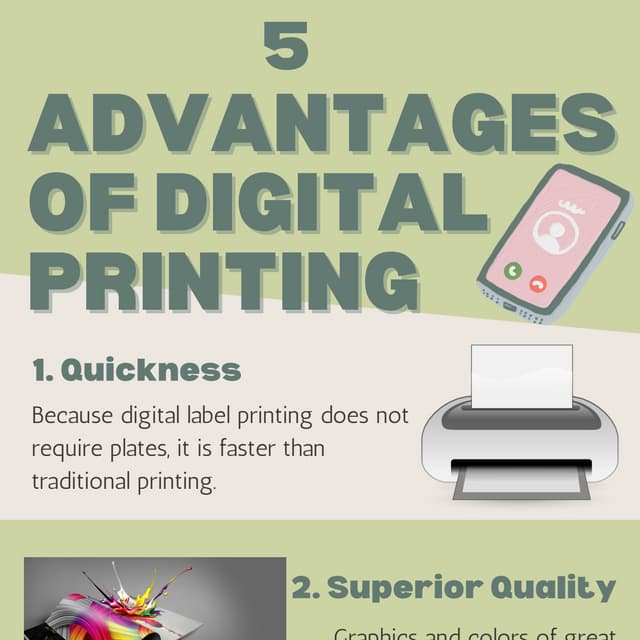Getting The Digital Printing To Work
Getting The Digital Printing To Work
Blog Article
What Does Digital Printing Do?
Table of ContentsSome Of Digital PrintingDigital Printing - The FactsEverything about Digital PrintingFascination About Digital PrintingThe smart Trick of Digital Printing That Nobody is Talking AboutIndicators on Digital Printing You Should Know
Variable information printing, such as direct mail with personalized codes and addresses, is ideally suited for digital printing. Digital fast printing just needs four steps of design, review, printing and binding to obtain every little thing done. Digital fast printing has an unrivaled advantage: print on need.According to PMMI, electronic printing enables brands and manufacturers to react rapidly to customer needs while boosting the supply chain, lowering warehousing price and waste, and enjoying faster time to market. That all audios great, however just how does this technology do all that? The major differentiator of these technologies is that there are no set-up costs and no plates with electronic printing.
The Best Guide To Digital Printing
This results in quicker turnaround time and lowers price when making use of digital printing.
Rapid manufacturing means getting your product to market faster. It also means it's much easier and faster to make modifications in the future, when you alter a recipe, add a SKU, or create seasonal packaging. Digital printing is very flexible, so it's very easy to make adjustments to the package style promptly. It all goes back to the plates.
A lot more inventory can mean more waste in the future. With conventional printing approaches, short-run printing is simply not feasible. Since an excellent layout can make or damage your product, electronic printing continually produces top notch, clear and vibrant graphics each time. Digital printing on versatile bags includes the intense, lively, and exact graphics that virtually beckon customers to connect and touch them.
Digital printing is the procedure of printing digital-based photos directly onto a variety of media substratums. There is no demand for a printing plate, unlike with balanced out printing. Digital data such as PDFs or desktop posting data can be sent straight to the electronic printing press to print theoretically, picture paper, canvas, fabric, synthetics, cardstock and other substratums.
The 4-Minute Rule for Digital Printing
According to PMMI, electronic printing allows brand names and producers to respond quickly to consumer needs while boosting the supply chain, decreasing warehousing expense and waste, and enjoying faster time to market. That all sounds great, but how does this innovation do all that? The major differentiator of these technologies is that there are no set up fees and no plates with digital printing.
According to Wikipedia, the best distinction between digital printing and standard approaches such as lithography, flexography, gravure, or letterpress is that there is no need to replace printing plates in electronic printing, whereas in these analog printing approaches home plates are consistently changed. This causes quicker turn-around time and lowers navigate to this website expense when making use of digital printing.

See This Report about Digital Printing
A lot more stock can suggest even more waste in the future. With standard printing approaches, short-run printing is simply not feasible. Since a great layout can make or damage your item, electronic printing continually develops top quality, clear and colorful graphics each time. Digital printing on flexible pouches includes the intense, vivid, and exact graphics that almost bid customers to connect and touch them.

According to PMMI, digital printing enables brands and producers to respond rapidly to customer demands while improving the supply chain, lowering warehousing price and waste, and enjoying faster time to check these guys out market. That all audios fantastic, however just how does this technology do all that? The significant differentiator of these technologies is that there are no set up costs and no plates with digital printing.
5 Easy Facts About Digital Printing Explained
According to Wikipedia, the best distinction between electronic printing and traditional techniques such as lithography, flexography, gravure, or letterpress is that there is no need to change printing plates in digital printing, whereas in these analog printing techniques home plates are repetitively replaced. This causes quicker turnaround time and decreases cost when making use of digital printing.
Quick production indicates getting your item to market quicker. It also indicates it's simpler and hop over to here faster to make changes later, when you transform a dish, include a SKU, or produce seasonal packaging. Digital printing is very adaptable, so it's easy to make changes to the plan layout quickly. Everything goes back to the plates.

Rumored Buzz on Digital Printing
Digital printing is the procedure of printing digital-based photos straight onto a variety of media substratums. There is no need for a printing plate, unlike with offset printing. Digital data such as PDFs or desktop computer posting files can be sent out straight to the digital printing machine to print theoretically, image paper, canvas, textile, synthetics, cardstock and various other substratums.
Report this page